
It is estimated that there are around 10,000 different spider species living across Australia. Australia is known for the large variety of venomous animals that live in the country and is also home to some of the most venomous spiders in the world. Only a few spiders are dangerous to humans in Australia, and most spiders pose no threats to us at all.
Spiders are interesting creatures, and each species has something to be discovered about it. Let’s take a look at 8 spiders in Australia.
1. White-tailed Spider (Lampona cylindrata)

The white blotch on the tip of the abdomen of the white-tailed spider is where this species gets its name.
©iStock.com/Natalia Marshall
All across Australia, white-tailed spiders are common in coastal regions. Fully grown, this spider is around 12 to 18 mm (0.47 to 0.70 inches) in size. It is gray or black, with white blotches on its body. The white mark near the tip of its abdomen is where this spider gets its name.
White-tailed spiders are mildly venomous to humans but are relatively harmless. Symptoms from bites of this species include redness, swelling, itchiness, and pain. White-tailed spiders are nocturnal and spend this time actively looking for food. During the day, they hide in secluded areas like rocks, logs, leaf litter, and around household clutter.
2. Huntsman Spider (Delena cancerides)
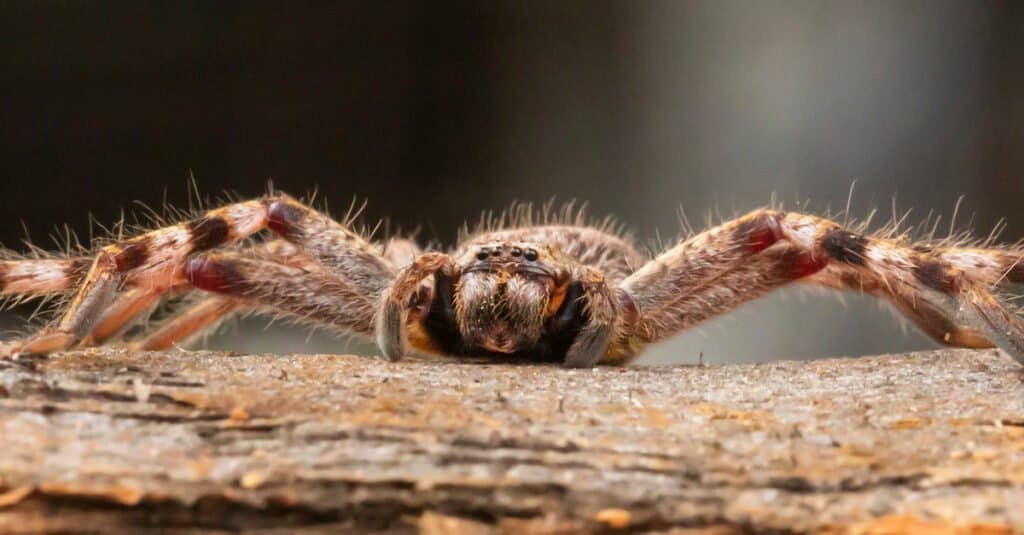
Huntsman spiders’ flat body allows them to squeeze into the smallest of crevices.
©Wright Out There/Shutterstock.com
The huntsman spiders are a huge species that live across Australia, and the giant crab spider is another name they are called. Ninety-five species of huntsman spider out of the total 1,207 primarily inhabit Australia.
This species lives in forests, vegetated habitats, and areas with ample natural debris. Active at night, during the day, this spider will hide under things like rocks, wood pieces, leaf litter, and other dark, secluded areas.
Huntsman spiders spend their night hunting and can prey on many animals due to their large size. Their body size is around 2.2 to 2.8 cm (0.86 to 1.1 inches), and they have a leg span of 0.7 to 5.9 inches. At night this spider feeds on animals like roaches, small lizards, and other invertebrates they come across.
Huntsman spiders are not dangerous and have a very docile nature. Their bodies are flat, allowing them to fit into small spaces and possibly get into your home. Large fangs from the huntsman spider produce a painful bite, but their venom is not medically significant to humans.
3. Australian Golden Orbweaver (Trichonephila edulis)
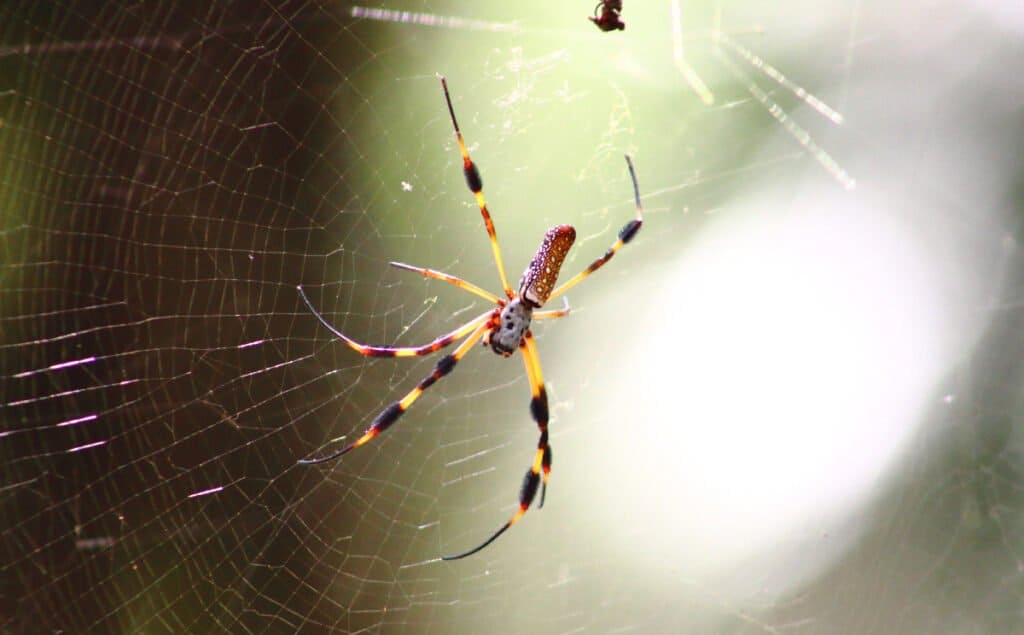
The golden silk orb-weaver and other similar species build larger orb-shaped webs to live in, with some built up to 5 feet large.
©Max Rossa/Shutterstock.com
The golden orb weaver is a spider that lives in Australia, common in woodland, forests, and coastal prairies. It is sometimes found in gardens, parks, and urban vegetated areas. Females create large circular webs with silk that has a golden shine.
Female Australian golden orb weavers are around 40 mm large (1.5 inches), while males have a body size of around 6 mm (0.24 inches). This spider has a silver-colored abdomen with long spindly legs. It is commonly seen in the spring, and mating occurs during this period.
Flying insects like flies, wasps, bees, and butterflies form the diet of the golden orb weavers. They feed on whatever gets caught in their web and use venom to neutralize their prey. Wasps are one of the most common predators, the golden orb weaver.
4. Whistling Spider (Selenocosmia crassipes)

The whistling spider is the largest in Australia.
©iStock.com/Ken Griffiths
A large species of tarantula native to the east coast region of Australia, the whistling spider, is the largest spider in the country. As the largest spider in Australia, whistling spiders can grow a leg span of up to 16 cm (6.2 inches) and a body size of around 6 cm (2.3 inches). The body of this spider is robust and covered in small hairs. Brown to grey-brown are the colors of this spider. Whistling spiders live in burrows and create homes up to a meter deep.
When provoked, the whistling spider creates a hissing noise. This spider has large fangs and bites from them are potentially dangerous. Symptoms like nausea and vomiting can occur for several hours if bit by this spider. Small animals like dogs and cats can potentially die from the venom of this spider.
5. Black House Spider (Badumna insignia)
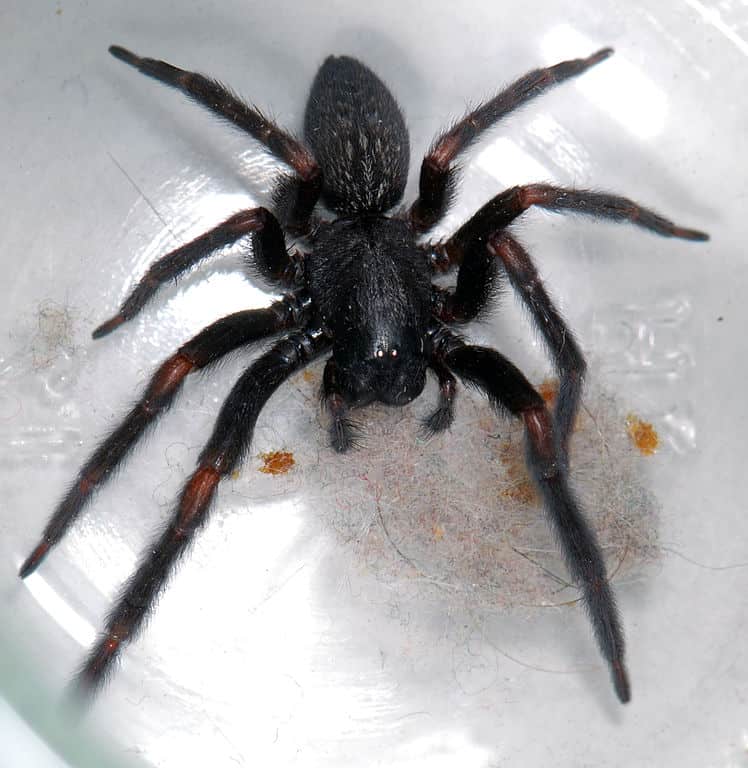
The blackhouse spider spends most of its time in its web, only coming out quickly to feed.
©Peter Halasz (User:Pengo) / CC BY-SA 2.5 – License
Found in southern and eastern Australia, the blackhouse spider is a species common in man-made structures. This spider builds messy webs to live in, usually made in secluded areas. Corners, on tree trunks, walls, rocks, and man-made structures are where this species lives. Females spend most of their lives in their web, while males wander around looking for a mate.
The black house spider is a harmless spider to humans and is common in Australia. Females of this species are around 18 mm, while males are only 10 mm. This spider has black or grey coloring, with small hair covering its body. Black house spiders are nocturnal and spin their lace-like webs during the night. Animals like flies, ants, butterflies, and beetles are what they feed on most often.
6. Redback Spider (Latrodectus hasselti)
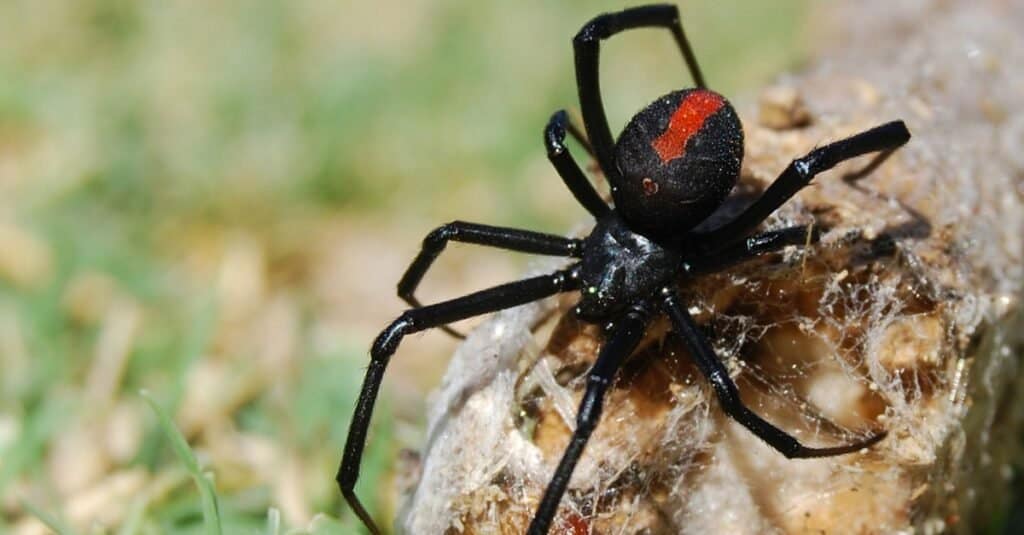
A female redback spider also called the Australian black widow, creates messy webs.
©iStock.com/maria72
The redback spider is a very venomous species native to Australia, found all over the country. This species is also called the Australian black widow and is named after the red marking on the female spider’s abdomen. Female redback spiders grow up to 15 mm (0.59 inches) large, while males are only around 3 to 4 mm (0.11 to 0.15 inches).
This spider creates messy cobwebs to live. Their webs are made in dark and secluded areas like flowerpots, kids’ toys, and on the sides of houses. It is common for this spider to live in a dry area near human structures. Small insects that get caught in its web are what this spider feeds on. They inject their prey, then wrap them up in their silk.
Redback spiders are one of the most dangerous spiders in Australia, but envenomation does not occur from all bites. Symptoms from this spider’s bite include pain, swelling, nausea, vomiting, fever, and heart issues.
7. Red-headed Mouse Spiders (Missulena occatoria)
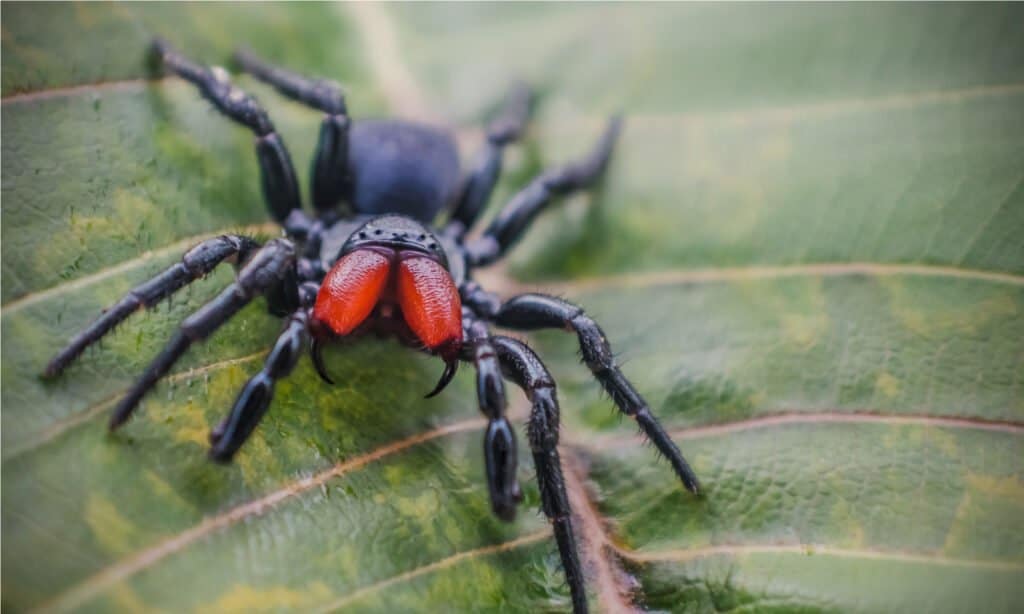
You can find the Red-headed mouse spider in Australia’s southern and northern regions.
©Brittany North/Shutterstock.com
The red-headed mouse spider lives in Australia and is mostly found in the country’s far north and south. This species lives in burrows, usually made near the banks of freshwater sources. Their burrows have a trap door entrance. Females of this species rarely leave their burrows, eating and laying their eggs in their homes. Males are sometimes seen in the summer, wandering around for a mate.
Males of this species have bright red heads and black coloring on the rest of their bodies. Females are larger and are sometimes more than double the size of males, and females have dark brown coloring. Full-grown red-headed mouse spiders are around 12 to 24 mm (0.47 to 0.94 inches). The venom of this species is potent and strong enough to kill a human. Insects are the main food source for this spider, but they also feed on small mammals like mice.
8. Sydney Funnel-web Spider (Atrax robustus)
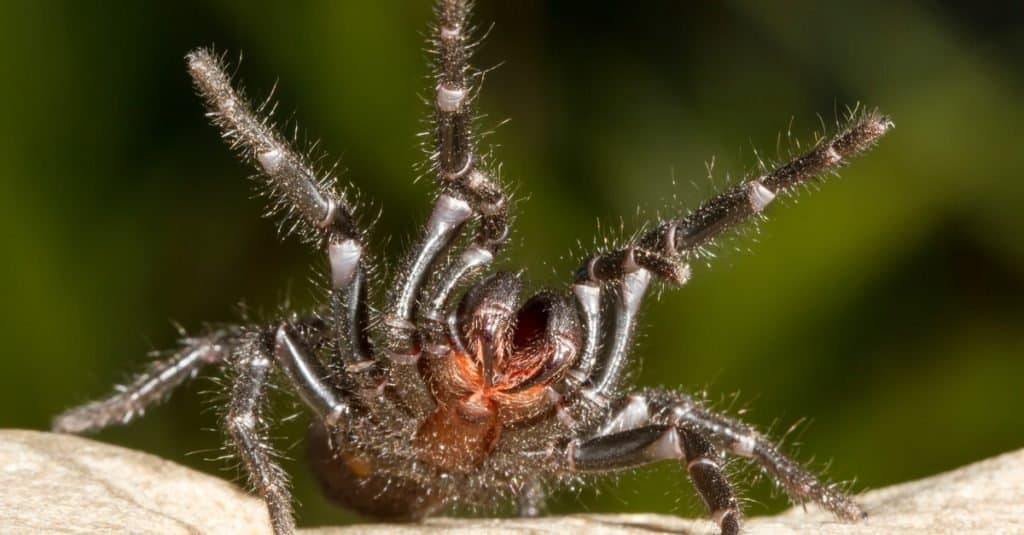
The Sydney funnel-web spider uses a silk-lined burrow to live in, with a trap-door lid.
©Ken Griffiths/Shutterstock.com
The Sydney funnel-web spider is the most venomous in Australia and among the most venomous spiders in the world. This spider is native to Eastern Australia and lives in a range a few miles from Sydney. This spider uses a silk-lined burrow to live in, with a trap-door lid. Humid habitats with natural debris are where this spider lives.
Due to its lifestyle, the Sydney funnel-web spider is not seen often, as it spends its life in its burrows. At night small animals like roaches, small lizards, and other spiders are eaten by them. The edge of their burrow is where this spider waits, and it waits until the prey is close enough to pounce on. Using the silk surrounding its burrow to sense when things are coming, this spider quickly strikes at its meal passing by.
The venom of this spider is extremely dangerous and can kill humans, their venom is neurotoxic and can cause death within 15 minutes.
Summary 8 Spiders In Australia
| Rank | Spider |
|---|---|
| 1 | White-tailed Spider |
| 2 | Huntsman Spider |
| 3 | Australian Golden Orbweaver |
| 4 | Whistling Spider |
| 5 | Black House Spider |
| 6 | Redback Spider |
| 7 | Red-headed Mouse Spiders |
| 8 | Sydney Funnel-web Spider |
What is the Least Dangerous Spider in Australia?
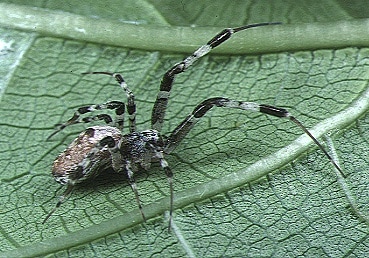
The grey house spider is the least deadly of the more than 10,000 species of spiders found in Australia.
©Akio Tanikawa, CC BY-SA 2.5 – License
Australia is home to an estimated 10,000 species of spiders and while they all have venom, of these, there are only a few that are considered dangerous to both children and adults. Since the majority of these arachnids have venom that only affects invertebrates, there is generally no cause for alarm. Adults need to only worry about two species – the Sydney Funnel-Web Spider and the Redback, while there are additional worrisome species for children – the mouse spider and the white-tailed spider.
The majority of spiders are not dangerous and should cause you to worry. Of these multitudes of arachnids, the least dangerous is the grey house spider (Zosis geniculatus). The majority of spiders have a mild toxin that is used on their prey, including the grey house spider, although it is not considered dangerous to humans. Should they bite you, while it may be painful, it will only cause pain and swelling in the bite area.
The photo featured at the top of this post is © iStock.com/KathrynWillmott
Thank you for reading! Have some feedback for us? Contact the AZ Animals editorial team.






